A mother has revealed how she diagnosed herself with a potentially-fatal genetic disorder after doctors passed off her terrifying symptoms as signs of grief over the death of her nine-day-old baby.
Mom-of-two Lindsey Raudabaugh, 30, from Pennsylvania, found herself bedridden for four months from March 2020 after suffering intense stomach pain along with vomiting and diarrhea nearly every day.
Over the next year and a half, she underwent multiple tests and surgeries, but doctors were unable to diagnose her – and one even went as far as to suggest that her illness was the result of PTSD from the death of her son Asher.
The newborn baby boy was born with a very rare congenital condition called tracheal agenesis, which means that he did not have a windpipe, and he passed away at just nine days old.
But while his death paved the way for new research into the condition, it also sparked a months-long health battle for Lindsey, who spent more than a year trying to get to the bottom of a series of horrific symptoms, from paralysis to hair loss.
It was only after Lindsey took matters into her own hands and began conducting research on her symptoms – only to eventually learn that she does in fact suffer from a condition known as hereditary hemochromatosis, a genetic disorder that can cause severe liver disease and an array of other health problems, and can be fatal if not treated early.

Struggle: A 30-year-old mother from Pennsylvania has revealed how she diagnosed herself with a life-threatening illness after doctors dismissed her symptoms as signs of grief

Suffering: Lindsey Raudabaugh began experiencing serious health struggles in March 2020, which began with vomiting and stomach pains and developed into temporary paralysis

Questions: Despite Lindsey’s symptoms continuing to worsen over time, doctors insisted that her health struggles were the results of grief, anxiety, and PTSD over the death of her baby son
Hereditary hemochromatosis is a condition that causes the body to absorb too much iron from the food that you eat, which is then stored in the organs – particularly the liver, heart, and pancreas.
Too much iron can lead to the development of life-threatening conditions, including liver disease, heart problems, and diabetes – meaning that early diagnosis is essential, something that Lindsey says she was unable to do as a result of her treatment by her doctors.
Now, Lindsey is speaking out about her experiences in the hopes of helping others who feel as though their illnesses are being dismissed by doctors – while calling for a change to the way in which medical experts diagnose their patients.
‘I was aggravated and angry because I wasn’t feeling anxious or mentally unwell’ said Lindsey.
‘I had a therapist who told me I was “hypersensitive by nature”, and that I needed to talk about anything other than my illnesses.
‘I attempted medication for both PTSD and anxiety to humor the doctors. None worked and some made my issues worse so I discontinued use immediately.’
Lindsey developed more symptoms, such as convulsions, temporary paralysis from her toes to her shoulders, hair loss across her entire head and weight loss of three-stone in less than three months, as well as her body’s cobalt rising to toxic levels – but doctors still had no answers for her.
She decided to take matters into her own hands, journaling her symptoms every day and researching them online.

Research: Lindsey and her husband Michael’s newborn son Asher passed away at just nine days old after being born without a windpipe

Options: After doctors failed to diagnose her symptoms, Lindsey began conducting her own research – while taking a myriad of drugs for PTSD and anxiety at the suggestion of experts
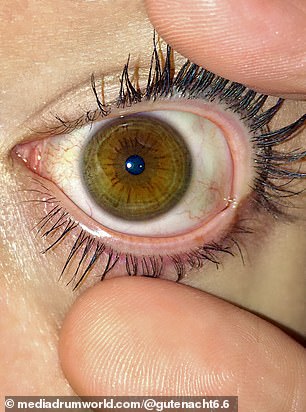

Tracking: She began to document her different symptoms, including discolored eyes and hair loss, and eventually discovered that she may be suffering from hereditary hemochromatosis
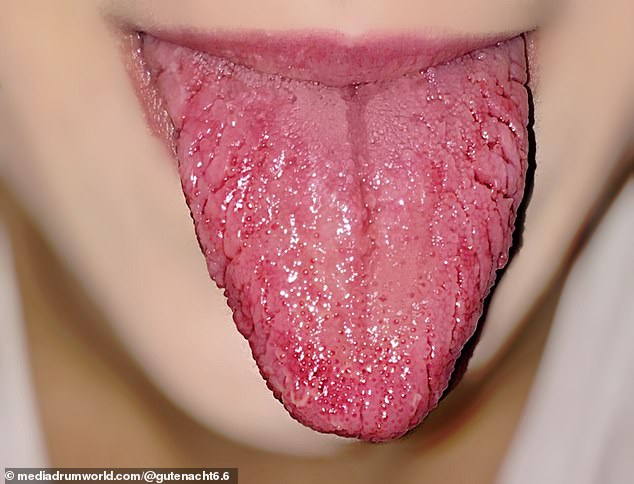
Painful: Hereditary hemochromatosis is a genetic disorder that can cause liver disease and an array of other health issues and the symptoms (including a cracked tongue) are very varied
‘I knew that my doctors would go home after their shift and not piece my case together,’ she said.

Observation: Lindsey charted everything in her daily routine to try and get to the bottom of her illness, even sampling her urine to show how it changed when she was feeling particularly sick
‘My body crises told me I was dying, so the only way for possible treatment in time was to figure it out myself.
‘I started journaling things like a mad scientist, and ended up writing more than 200 pages across a year and a half. I would do home tests since I didn’t have access to real lab tests while I suffered throughout the night.
‘As I wrote all of this down, I started backtracking. The more I wrote of my past, the more I saw correlation.
‘Why did I feel sick and exhausted my whole life? Why did I have a son with a rare disease and two other rather complicated births? What is giving me tremors at 30 years old? The list of questions went on and on.’
Through the process of elimination, Lindsey came across hereditary hemochromatosis, a genetic disorder that can cause severe liver disease and an array of other health problems, and can be fatal if not treated early.
She had her iron tested twice to confirm her suspicions, and received the results on September 29, 2021 – proving that she did have hereditary hemochromatosis.
‘I feel over the moon now that I have a name and a hope for treatment to feel better, or a chance to lessen my ‘attacks’,’ she said.

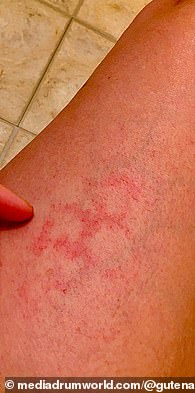
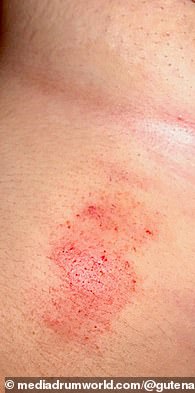
Pain: She also began suffering from rashes and red marks all over her body – which she also learned are symptoms of her condition
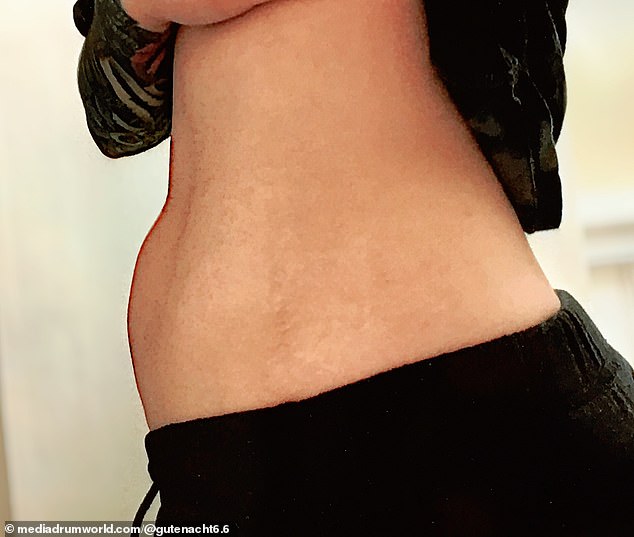
Where it all began: Lindsey first realized that something was wrong when she started experiencing agonizing stomach pains, bloating, vomiting and diarrhea
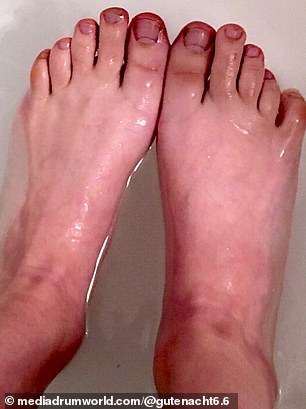
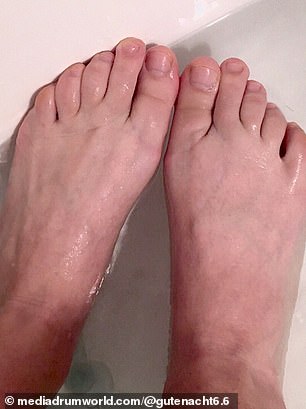
Indicator: One of the symptoms of hereditary hemochromatosis is joint and foot pain – which Lindsey suffered from whenever she was experiencing a flare-up (left)
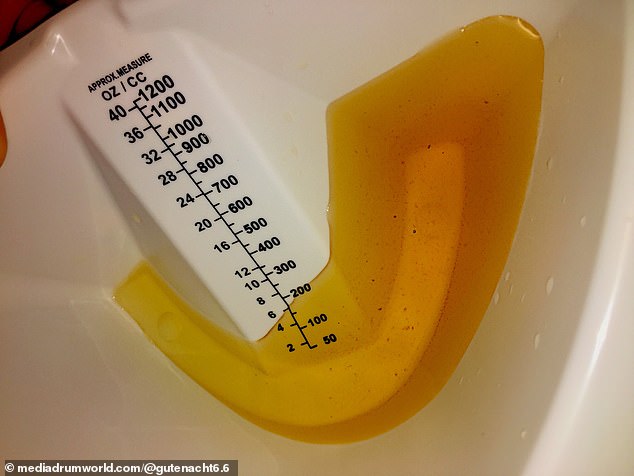
Shocking: Lindsey began throwing up bile every day for months – and would take samples of it to show her doctors
‘I absolutely would have died if I hadn’t carried out my research. I haven’t started treatment yet and I do not know yet what is in store for me, or if any of this has caused permanent damage.
‘However, I knew that if I got the right diagnosis and if I had started some kind of treatment that my chances would be higher at successfully combatting and managing the process of the disease itself.
‘I feel hopeful for my children’s future as well, which was most important to me.
‘I’ve come to terms with the downfalls of my disease and I have both my bad days and good days.
‘I feel resilient when it comes down to making an impact on others who suffer the same fate and I also feel very strong and positive that we will make a change over time in raising awareness for undiagnosed diseases.
‘Looking back now, why did no one believe me when I began having fainting spells in 2015? Because my tests show up normal and inconclusive? It angers me.


Evolution: She also snapped selfies to show how her appearance changed on days when she was feeling unwell (right) versus days when she felt healthy (left)

Fears: Lindsey, who has two children with her husband, believes she ‘absolutely would have died if she hadn’t carried out her research’


Upset: She also doesn’t know yet whether her undiagnosed condition has caused permanent damage to her body
‘Although I’m a put-together, rather young and seemingly ‘healthy’ 30-year-old, I am insanely aggravated that I was dismissed so often and still am, even with diagnosis.
‘No-one ever warned me, ‘all of these things together is a sign of trouble, keep an eye on your health’.
‘If I had never found my disease, it would have ended up claiming my life regardless and it all would have been for nothing.
‘But I am grateful that I have a name. To prove medical professionals wrong, to defy odds, to help those who suffer. It’s not mental, although one would go crazy dealing with this.
‘It starts with doctors. They need to stop categorizing everything that they can’t physically see as mental health.
‘They should also screen for iron or other necessary tests when CBC blood panels and vitals are normal; tests are inconclusive, yet the patient is still suffering a myriad of symptoms.
‘I also think it’s crucial that people – no matter their age – listen to their bodies, take their symptoms into great consideration, and advocate for themselves.’
The rare condition that can cause liver disease and heart problems without you ever knowing: What IS hereditary hemochromatosis and what are the symptoms?
Hereditary hemochromatosis is a potentially-fatal condition that causes the body to absorb too much iron from food and then store it in its organs, particularly the heart, liver, and pancreas.
The excess iron in these organs can lead to a variety of serious health conditions, including liver disease, heart problems, and diabetes – meaning that early diagnosis is essential to prevent any permanent damage for sufferers.
For some people with hereditary hemochromatosis, symptoms may never develop and for those who do experience health issues, the condition can be difficult to diagnose because the early symptoms are often confused with other illnesses.
SYMPTOMS
Symptoms and signs of hereditary hemochromatosis include:
Joint pain Abdominal pain Fatigue Weakness Loss of sex drive Diabetes Impotence Heart failure Liver failure Bronze or grey skin color Memory fog
Because the condition is hereditary, people who suffer from it are born with the illness, however many people only experience symptoms later on in life – typically after age 40 for men and after age 60 for women.
DIAGNOSIS
Hereditary hemochromatosis is difficult to diagnose, however the best way to detect whether a person is suffering from the condition is with blood tests.
These can be used to highlight whether a person has excess iron in their blood – while liver function tests and MRIs will help to measure whether the condition has led to any other issues in the body.
TREATMENT
The condition is usually treated with regular phlebotomies, a procedure in which blood is removed from the body in order to regulate the amount of iron a person is storing.
Advertisement
Source link : https://www.dailymail.co.uk/femail/article-10072617/Mother-30-diagnoses-rare-life-threatening-condition.html











